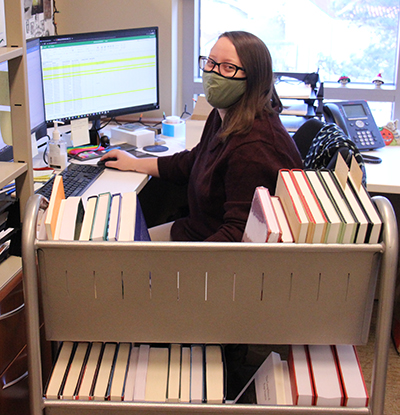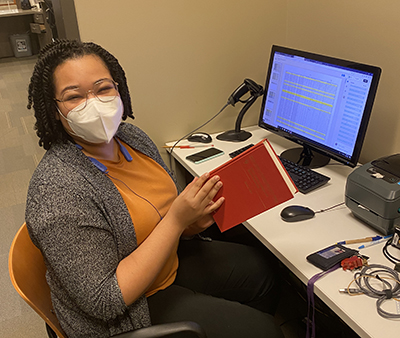Anti-racism work is a strategic priority for Candler’s Pitts Theology Library, and two staff members have recently undertaken a project to rectify examples of systemic racism hidden in plain sight in the library’s call numbers.
 Pitts Cataloging and Metadata Librarian Brinna Michael (pictured right) says the project arose after she heard an Emory colleague present about work to address racist and harmful language in library spaces. In libraries, one of the less obvious but most insidious occurrences of harmful language can be introduced when assigning a book’s “cutter number” or “cutter.” Part of a library book’s call number, the cutter is an alphanumeric code that follows the subject classification code and provides more specific information about the book’s subcategory within a related topic. Cutters are predetermined by the Library of Congress classification system, which is followed by most academic and research libraries in the United States, including Pitts.
Pitts Cataloging and Metadata Librarian Brinna Michael (pictured right) says the project arose after she heard an Emory colleague present about work to address racist and harmful language in library spaces. In libraries, one of the less obvious but most insidious occurrences of harmful language can be introduced when assigning a book’s “cutter number” or “cutter.” Part of a library book’s call number, the cutter is an alphanumeric code that follows the subject classification code and provides more specific information about the book’s subcategory within a related topic. Cutters are predetermined by the Library of Congress classification system, which is followed by most academic and research libraries in the United States, including Pitts.
To illustrate, take the call number BS680.E84, which tells us that this book is about ethics in the Bible. “BS” is the Library of Congress’s broad classification for works about the Bible, “680” is a slightly narrower classification for works with specific topics within the Bible, and “.E84” is the cutter specifying the topic as Ethics, with E as the first letter of Ethics, 8 representing the second letter of Ethics, and 4 representing the third letter in Ethics.
 This fall, Michael and Stacks and Circulation Specialist Yasmine Green (pictured right) have worked together to develop a process for updating the cutters .N4 and .O7 in the Pitts catalog, which stand for the terms “Negro” and “Oriental” respectively. About 500 books in Pitts’ holdings included these cutter numbers.
This fall, Michael and Stacks and Circulation Specialist Yasmine Green (pictured right) have worked together to develop a process for updating the cutters .N4 and .O7 in the Pitts catalog, which stand for the terms “Negro” and “Oriental” respectively. About 500 books in Pitts’ holdings included these cutter numbers.
Michael and Green chose to update the cutters based on geography, using updates the Library of Congress has previously made as a guide. If a book was more specific to the United States, they changed the cutter to .A35, for “African American.” If it were more broadly applicable globally, they used .B5, for “Black.” The .O7 cutter was changed to .A82, for “Asian or Asian American.
“What has stuck out to me most throughout this project is that we still have such a long way to go,” Michael says. “In many ways, this is only a surface fix for a deeply rooted, underlying problem that has been codified into the classification system itself. Since the Library of Congress classifications were created in the early 1900s by a group of white, primarily Christian men, it is those perspectives which underpin the entire structure.”
She notes that while the Library of Congress classification documents are regularly updated, “without a full rehaul, the system itself will continue to support the normalization of the white male experience.”
Since beginning the project, Michael has continued researching more about efforts in the library cataloging and technical services fields to try and counteract systemic racism.
“My hope is that this will be the first step towards improving the way we go about cataloging and classifying materials at Pitts. Though this is largely a cosmetic change, I hope it shows our patrons that we are dedicated to continuing this type of work and addressing issues of racism in the catalog and on our shelves.”
Top photo: A shelf of books containing the former cutter number .N4 (left). Books in Pitts’ collections have now been updated to .A35 (right) or .B5.
